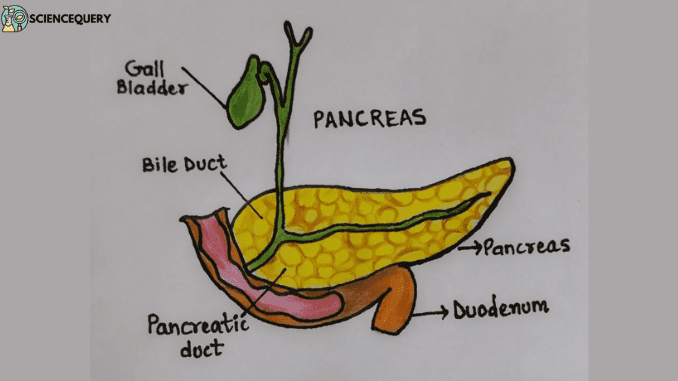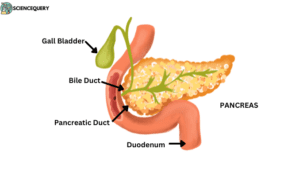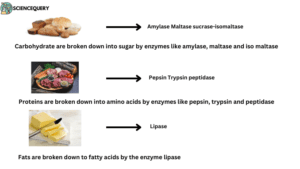
Introduction
The pancreas, also called a mixed gland, plays an important role in digestion. The enzymes secreted by the pancreas are called pancreatic enzymes to break down foods. It includes amylopsin, trypsin, and steapsin. The pancreatic enzymes are stored in the form of zymogen granules. Enzymes are active proteins and the final form of biocatalysts. They are hydrolyzed and absorbed easily.
Pancreas: Function and Anatomy

The pancreas is a vital organ located in the abdomen, just below the stomach. It produces hormones like insulin that helps regulate blood sugar levels and glucagon hormone that stimulates the liver to release glucose into the bloodstream.
Produces enzymes that break down molecules and provide energy. It breaks down fats, protein, and carbohydrates to readily absorb them.
The anatomy of the pancreas comprises
- An outer layer called a capsule: These are the pancreatic tissues made up of special acini.
- Connective tissues: These consists of nerves, lymph vessel, and ducts
- Pancreatic juices: The pancreatic lipase released by acini contains enzymes for digestion. Pancreatic lipase is a fat digestive enzyme that hydrolyses fats in stages.
Complete hydrolysis of a fat molecule gives about three fatty acid molecules and one glycerol molecule.
Endocrine and exocrine functions of the pancreas
The endocrine function of the pancreas is to produce hormones such as insulin, glucagon and somatostatin that help in regulating blood sugar levels. It secretes pancreatic juices from its exocrine part into the small intestine which aids in the digestion processes.
Pancreatic juice is alkaline having a pH of 8.8. It has three inactive proteases namely pancreatic amylase, pancreatic lipase and two nucleases. The proteases include:
- Trypsinogen: activated by enterokinase that breaks proteins into peptides.
- Chymotrypsinogen: Converts proteins into peptides.
- Procarboxypeptidase: Activated by trypsin and reduces peptides to amino acids and dipeptides.
Pancreatic Enzymes and their role in digestion

Amylase
Pancreatic amylase is an enzyme that hydrolyses starch and glycogen to dextrin and then to maltose, and isomaltose and limits the dextrin.
This complete digestion takes place in the small intestine. Various factors such as pH and temperature are the regulatory factors of the working of enzymes. The optimum temperature ranges from 32 – 37 degrees Celsius.
Pancreatic Lipase
Pancreatic lipase hydrolyses fats to fatty acids, glycerol, monoglycerides, diglycerides, and triglycerides.
This enzyme is known to break down fats in the human digestive system. It is secreted by the duodenal region.
The bile salts that are stored in the duodenum are responsible for the emulsification of large fat droplets into smaller droplets. It increases the surface area and thus helps in the easy breakdown of fat molecules. The micelles formed by the resulting fatty acids and monoglycerides are absorbed in the intestine. These molecules are then transferred to the bloodstream, known as chylomicrons.
Proteases
The secretion of the pancreas contains inactive precursors that react with an enzyme enterokinase to occur in its active state. Proteases act as inactive proenzymes to protect the lining of mucous membranes in the gut from hydrolysis.
Secretion and Regulation of Pancreatic Enzymes
The semi-digested food, known as chyme is passed into the duodenum through the pyloric sphincter. The chyme receives bile, pancreatic juice (stored in the gallbladder), and intestinal juices.
The acinar cells of the pancreas secrete the pancreatic juice. It contains a carbohydrate-digesting enzyme- pancreatic amylase that remains in inactive forms. They are known as trypsinogen, chymotrypsinogen, pancreatic lipase, carboxy polypeptidase, bicarbonates, and water.
- Amylase hydrolyses starch and glycogen to dextrin and then to maltose, and isomaltose and limits the dextrin.
Amylase
Starch + Glycogen →maltose +isomaltose
Protein digesting enzymes
- Trypsinogen is activated to trypsin by an enzyme enterokinase, present in the intestinal juice.
Enterokinase
Trypsinogen→Trypsin
Proteins→Peptides
- Chymotrypsinogen is activated by trypsin. The latter then splits proteins into peptides.
Trypsin
Chymotrypsinogen → Chymotrypsin
Chymotrypsin
Proteins →Peptides
Procarboxypeptidase is activated by trypsin. These enzymes separate individual amino acids adjacent to the free terminal carboxyl group of peptides.
Trypsin
Procarboxypeptidase→Carboxypeptidases
Carboxypeptidases
Peptides →Dipeptides + Amino acid
Pancreatic Lipase hydrolyses fats in stages. Lipase separates fatty acids from the emulsified triglycerides, changing them into diglycerides, and then into monoglycerides.
Hence, complete hydrolysis of a fat molecule gives about three fatty acid molecules and a glycerol molecule.
Enzyme Deficiencies and Disorders
S/N |
Enzymes |
Diseases |
| 1 | Amylases | GIT disease, Rickets, Bone diseases, jaundice |
| 2 | Lactase | Lactose Intolerance |
| 3 | Adenosine deaminase | Autosomal Recessive disorders due to autoimmune insufficiency. |
| 4 | DNase | Cystic fibrosis ( caused by mutation in gene ) – CFTR gene |
| 5 | Alpha-galactosidase | Fabry’s Disease – continuous buildup of glycolipids results in dysfunction, and hence multiple organ failures |
| 6 | Beta-galactosidase | Gaucher’s disease- an inherited disorder from parents that causes thrombocytopenia and excess accumulation of lipids. |
| 7 | Creatine kinases | Myocardial infarction and muscle disorders. |
How to detect disorders and deficiencies?
There are a lot of ways to find out the disorders that include:
- Imaging Techniques – The use of advanced imaging such as CT scans, Magnetic Resonance Imaging are used to detect potential defects in organs.
- Endo Biopsy– A small amount of tissue is taken from the intestinal tract to examine the abnormalities present.
- Blood Tests – Analysis of blood samples to detect any abnormalities in the patient’s body.
- Gene Testing – The DNA of an individual is tested to find out the possibilities of interfering with the processes of the pancreas and its reactions against it.
- Physiological tests are done to find out the ranges of enzymes present in an individual, for the system to work properly.
- Endocrine Testing – To measure the levels of insulin and glucagon levels in the body.
Vital Role of Pancreas in Digestion
- The pancreas plays a key role in digestion by making pancreatic enzymes like amylases, proteases, and lipases. These enzymes break down food into simpler forms, ready to be absorbed by the small intestine.
- The human pancreas produces about 8 ounces of digestive enzymes that are required for the digestion of daily intake of food. This organ also contains certain cells that play a major role in the production of hormones. They are chemical messengers that are released into the bloodstream to send messages to the body.
- Insulin hormone controls the blood sugar levels in the body. A decline in sugar levels increases sugar levels in the body, resulting in diabetes. Gastrin hormone contains mainly hydrochloric acid and pepsinogen. The hormones promote gastric motility and secretions into the stomach.
- Glucagon hormones are produced by the alpha cells in the pancreas. This hormone directs the liver to release the stored sugars in the bloodstream when the blood sugar levels are low.
Q&A
1. What are the three pancreatic enzymes?
The three pancreatic enzymes include pancreatic lipase, amylases, and proteases.
2. What is the function of pancreatic enzymes?
Ans: The main function of pancreatic enzymes is to break down the starch, fats, and sugars in the food, to simplify the digestion process in an individual. These enzymes are also responsible for managing blood sugar levels.
3. What are pancreatic enzymes?
The functioning of the pancreas is to digest food and endocrine function supports controlling blood sugar levels.
4. What happens when your pancreatic enzymes are high?
The overproduction of enzymes can lead to inflammation of the pancreas, causing a condition called Pancreatitis.
Pancreatitis occurs when the enzymes become hyperactive leading to swelling of the pancreas. Factors like excess alcohol consumption, diabetes, and obesity can also lead to chronic pancreatitis. Thus a low-fat diet, intake of fluids, and avoiding alcohol consumption are some of the simple ways to cure pancreatitis.
Summary
- The pancreas is one of the important organs located in the abdomen. It helps in digestion by making pancreatic enzymes like amylases, proteases, and lipases.
- These enzymes break down food into simpler forms, ready to be absorbed by the small intestine.
- The human pancreas produces about 8 ounces of digestive enzymes which are stored in the form of zymogens’ granules.
- Acinar cells of the pancreas secrete pancreatic juice.
- Pancreatic amylase hydrolyses starch and glycogen to dextrin and then to maltose. Hydrolysis of a fat molecule gives about three fatty acid molecules and a glycerol molecule.
- Protein digestion is completed in the small intestine.
- Pancreatitis is a medical emergency condition where the enzymes become hyperactive leading to swelling of the pancreas.
References
https://accpjournals.onlinelibrary.wiley.com/doi/abs/10.1592/phco.27.6.910
https://www.tandfonline.com/doi/abs/10.2147/CEG.S168266
https://karger.com/ofa/article/15/1/70/828897
